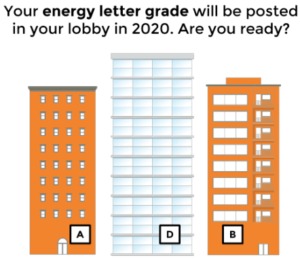

Blog
NYC’s building owners and real estate management firms now have one more thing on their plate to consider: Local Law 33 of 2018. LL33 compliance will assign letter grades to buildings required to benchmark energy and water consumption.



NYC’s building owners and real estate management firms now have one more thing on their plate to consider: Local Law 33 of 2018. LL33 compliance will assign letter grades to buildings required to benchmark energy and water consumption. The energy efficiency score will relate to the Energy Star Rating earned using the U.S. EPA Energy Star Portfolio Manager (PM). The law will come into effect on January 1, 2020, and will utilize the previous year energy data to set the energy efficiency score and letter grade as follows:
A – score is equal to or greater than 85;
B – score is equal to or greater than 70 but less than 85;
C – score is equal to or greater than 55 but less than 70;
D – score is less than 55;
F – for buildings that fail to submit required benchmarking information;
N – for buildings exempted from benchmarking or not covered by the Energy Star program.
Property owners should be made aware that if their property earned an energy efficiency score of 75 for the 2018 Benchmarking filing, the new score for the 2019 benchmarking filing may have fallen as much as 20 points. In LL33 terms, what could have been a letter grade “B” could now be “C” or “D” based on PM updates implemented in August 2018. Property owners will want to learn how the Energy Star PM update will affect their LL33 letter grade.
To understand the correlation and impact that the August 26, 2018 Energy Star PM update will have, it is important to look back at what took place as part of that update.
Energy Star PM uses energy performance metrics based on the Commercial Building Energy Consumption Survey (CBECS) conducted by the U.S. Department of Energy’s Energy Information Administration (EIA). The energy performance metrics includes utility usage for buildings nationwide with the same primary use. The study is conducted every four years; however, EIA was unable to release the 2007 CBECS update and therefore all energy efficiency scores prior to August 2018 relied in 2003 data. Prior to 2003, energy efficiency and carbon reduction goals did not play a major role in daily operations and therefore the 2003 energy performance metrics favored buildings with high Energy Use Intensities (EUIs). In simple terms, the 2003 energy performance metrics set the bar low and it was “easier” for buildings that had implemented “low hanging fruit” energy conservation measures, such as lighting upgrades or HVAC reset schedules to achieve a higher score.
The August 26, 2018 updates incorporated new data compiled by CBECS in 2012 and released in 2016. The inclusion of newer more efficient buildings and buildings that had incorporated aggressive carbon reduction goals in the 2012 data set resulted in an overall reduction of the average EUI for the nationwide building stock. Thus, setting a higher standard for the energy performance metrics used by Energy Star PM to assign energy efficiency scores. Upon release of the update in PM, scores for most building types have gone down as much as 20 points.
This brings us back to the question: how does the Energy Star PM update affect my LL33 letter grade? As previously mentioned, prior to August 2018, a building would achieve a “B” with a score of 75. After the update, the score would most likely fall to “C” or “D” depending on multiple factors.
Steven Winter Associates (SWA) and Sentient Buildings have created an online resource to serve as a forum for understanding Smart Buildings and their role in meeting NYC’s energy grade mandate. Smart Buildings capitalize on your existing systems and create a flexible platform for strategic upgrades in the future as building needs and technology options change.

Visit www.SmartBuildings.NYC to see how your building can become a smart building.
The first step to fine-tuning your Energy Star score is to ensure that all inputs are the most accurate representation of building operations. SWA will replace default values with actual values and check data for accuracy.
The next steps include performing energy feasibility studies to identify deep energy retrofits, developing energy master plans, and encouraging tenant engagement.
Contact us today to discuss ways in which your building can be improved to receive the best grade possible.
Contributor: Giovanny Bedoya, Senior Mechanical Engineer
Steven Winter Associates